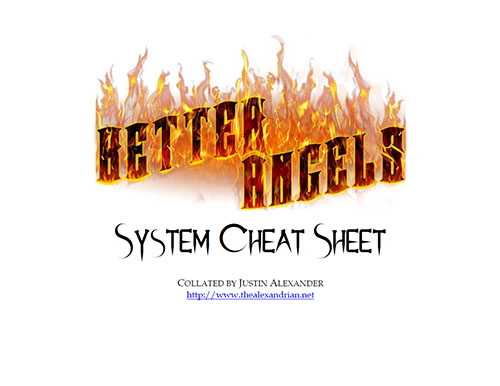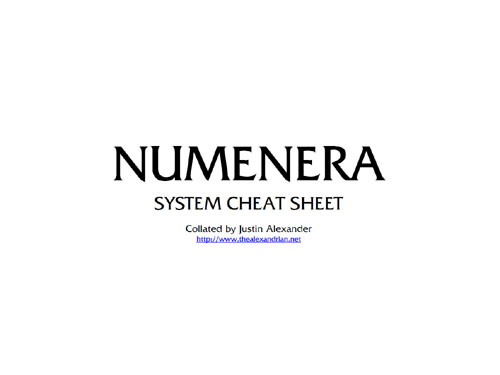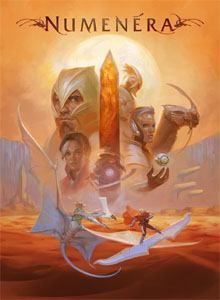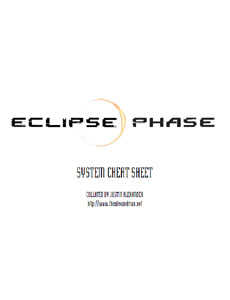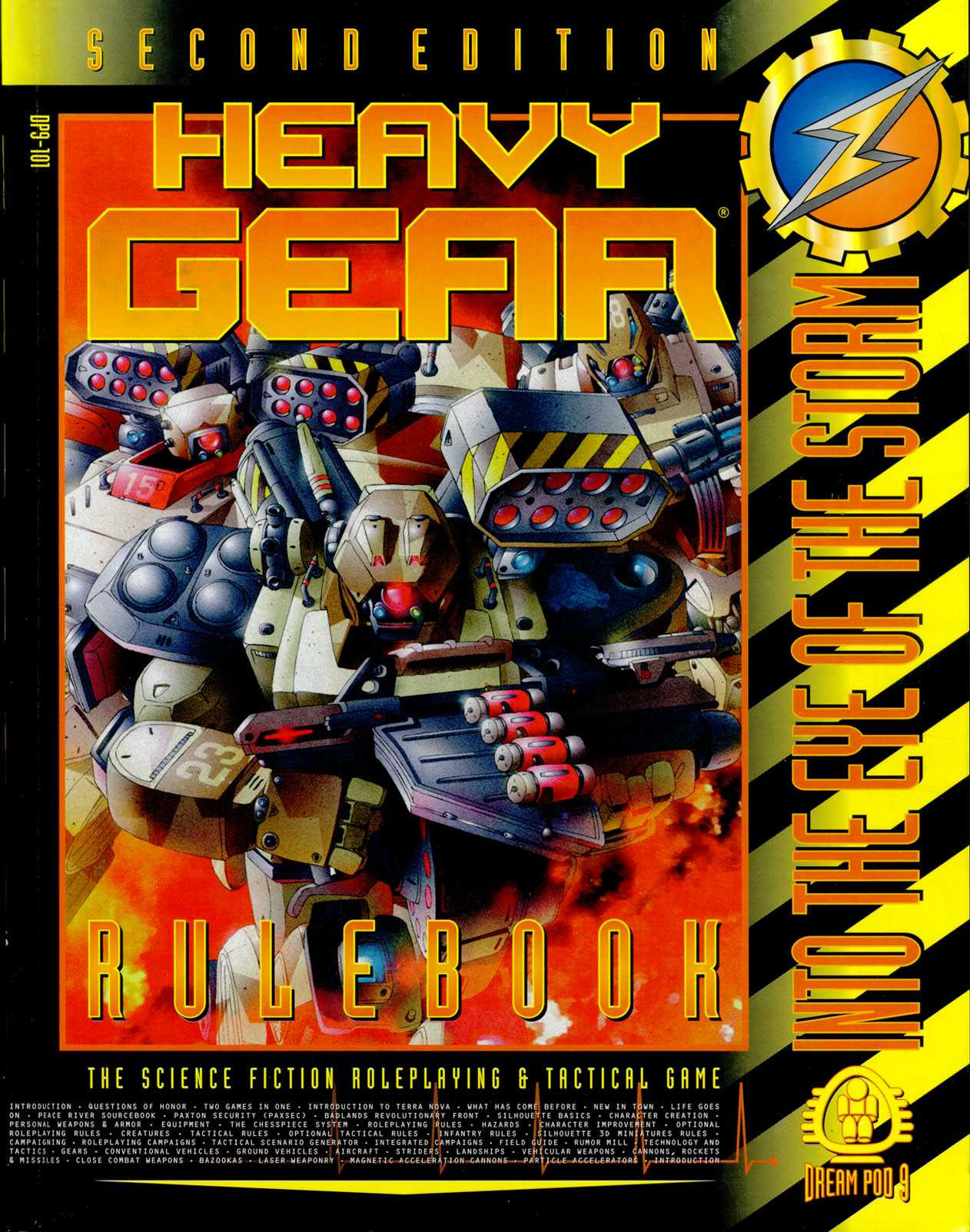I’ve done several of these cheat sheets now, but for those who haven’t seen them before: I frequently prep cheat sheets for the RPGs I run. These summarize all the rules for the game — from basic action resolution to advanced combat options. It’s a great way to get a grip on a new system and, of course, it also provides a valuable resource at the table for both the GMs and the players. (For more information on the procedure I follow when prepping these cheat sheets, click here.)
This set of cheat sheets is for Better Angels, a One Roll Engine game from Greg Stolze and Arc Dream Publishing. The core concept of the game is that supeheroes and supervillains have their powers because they’re possessed by angels and demons, respectively.The conceit that makes this compelling, however, is that the supervillains are actually trying to mitigate the evil of the demon inside them: See, if a demon ends up inside of a goody two-shoes who refuses to do any evil in their name, the demon gets bored and leaves. That’s a problem, because every time a demon shifts to a new host there’s a chance they’ll end up inside of someone who is truly evil: A Jeffrey Dahmer or a Hannibal Lector with the powers of a demon is capable of truly despicable acts. So if you end up with a demon inside of you, the argument goes, the best course of action is to keep them entertained with evil acts that are big and splashy, but ultimately not all that harmful to the people around you.
In other words, you do all the wacky stuff that pulp era supervillains did: You kidnap the Statue of Liberty and hold her for ransom. You have whales swallow explosives. You burn down the mansion of Big Bank, Inc.
The problem, of course, is that demons are actually pretty good at that whole “corroding your soul” thing. So while you’re trying to do splashy-but-limited-damage evil, the demons are actively working to make you compromise just a little bit more; sacrifice morals you thought were sacrosanct; cross lines you promised to never cross.
And, mechanically speaking, what makes this concept really pop and turned the game into a must-play for me is that each player is responsible for both their Mortal character and for the Demon of the character to their right. This dual-role dynamic forces the conflict between Mortal and Demon into the open and the rules of the game expertly model the ethical battlefield / minefield that the characters are all trying to traverse on tightropes.
HOW I USE THEM
As I’ve described in the past, I keep a copy of the system cheat sheet behind my GM screen for quick reference and also provide copies for all of the players. Of course, I also keep at least one copy of the rulebook available, too. But my goal with the cheat sheets is to consolidate information and eliminate book look-ups: Finding something in a half dozen or so pages is a much faster process than paging through hundreds of pages in the rulebook.
The organization of information onto each page of the cheat sheet should, hopefully, be fairly intuitive. The actual sequencing of pages is mostly arbitrary.
Page 1: I’ve adopted the green/purple distinction between Strategies and Tactics from the Better Angels rulebook. Understanding the explicit sinister/virtuous antithesis between each Strategy and Tactic is the core of the system and that’s headlined here along with an overview of the incredibly simple ORE mechanic.
Page 2: And here you’ve got pretty much every other mechanic in the game. (New players mostly just need to understand the “Damage” column here; everything else is relatively nonessential for launching your first session.)
Page 3 / Page 4: Demonic Prerogative and Domain of the Human cover everything you need to know about playing each of your characters. For Better Angels to really work, the players all need to understand the full dynamic of the game’s central conflict. (It’s particularly important to grok the methods a Demon has for mechanically corrupting their host and the methods a Mortal has to maintain or regain their moral equilibrium. Being clear on each side’s “end game” is also important.)
Pages 5-7: As I’ve discussed in the past, I generally don’t put “character option chunks” in the cheat sheet. The superpowers in Better Angels, however, are generally pretty streamlined. As a GM I also found it easier to parse NPC stat blocks with a power cheat sheet. And, last but not least, players found it useful because the effect of each power in Better Angels varies based on your current stats (and those change frequently and rapidly); so it’s not like other games where you can really familiarize yourself with your current powers.
Page 8: The ability to construct devilish devices (a.k.a. supervillain death-rays) is something I saw new players overlooking, so the full procedure gets highlighted here. (This isn’t “first session critical”, but it’s something I’d consider reviewing at the start of the second session.)
Page 9: This page has all the mechanics the GM needs in order to run angelic NPCs / superheroes.
WHAT’S NOT INCLUDED
These cheat sheets are not designed to be a quick start packet: They’re really useful as a tool for an experienced player teaching the game to new players, but you’ll find it really difficult to learn the game from scratch by just reading through them. (They are an adjunct to the core rulebook, not a replacement.)
You also won’t find most of the optional rules for the game.
MAKING A GM SCREEN
These cheat sheets can also be used in conjunction with a modular, landscape-oriented GM screen (like the ones you can buy here or here).
Personally, I use a four-panel screen and use reverse-duplex printing in order to create sheets that I can tape together and “flip up” to reveal additional information behind them. For Better Angels my screen looks like this:
- Page 1: Basic Mechanics (with Demonic Prerogative & Domain of the Human behind it)
- Page 2: Other Mechanics (nothing behind it)
- Demonic Aspects (with both pages of Demonic Powers behind it)
- Angels (with Devilish Devices and the logo sheet behind it)
I hope you find these useful!

